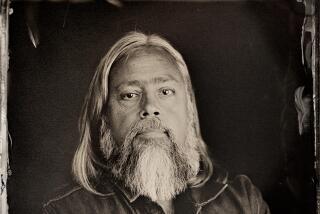Barbarian Among the Eskimos : Trust Me On This
- Share via
I’ll never forget my first “Kabloona.”
It was more than 20 years ago, the day I arrived on Cape Breton Island in Nova Scotia, that a close friend pressed a been-around copy of that curiously titled book into my dubious hands and simply said, “Read this.” He knew, as I was soon to find out, how superfluous it would have been to say more about this delightful story, so unique in its sensibility and so refreshing in its point of view.
First published in 1941, “Kabloona” describes the 15-month, 20,000-mile journey that its author, Frenchman Gontran de Poncins, made to the Eskimo lands near the North Pole. A vicomte and descendant of Montaigne, Poncins, according to notes that collaborator Lewis Galantiere wrote for the Book-of-the-Month Club edition, had become disenchanted with “the selfishness of our world, the ungenerosity of man to man,” and had taken to wandering in places like China, India and the South Seas to see if he could discover any alternative. “Surely of all things in the world the rarest is a civilized man at peace with himself,” De Poncins writes with typical candor in “Kabloona’s” preface, and his trip to the far north was an attempt to see if that barren area could in some way provide the contentment he sought.
Certainly De Poncins’ odyssey didn’t begin as he’d envisioned; he found the first Eskimos he met to be “actually sordid, physically repugnant, and possessed by a nature in which I could see none of the generous hospitality of primitive peoples elsewhere.” So while the book is nominally about an arduous physical journey, it’s really about an even more strenuous psychological and spiritual one, about how this cultivated Frenchman came to see that it was not the Eskimo but he himself who was the uncultured savage.
Nowhere is De Poncins’ change of heart and mind more evident than in the drolly self-deprecating title he chose for the book. For Kabloona is the Eskimo term for white man, and it’s not what you’d call a complimentary one. To the Eskimo mind, to be a Kabloona is to be the sorriest fool the Earth has ever seen, a figure of fun, not to say contempt.
Take the Kabloona idea of justice, for instance. What did they do to a murderer? “They housed him warmly; they gave him clothes to wear; they fed him well and brought him all the tobacco he could smoke. . . . Precisely because he had killed man he was freed from every hardship.”
Equally inane was the Kabloona’s fascination with fox skins: “Even to wipe things with, the ptarmigan makes a better rag. It isn’t possible that the white man should have so many things that need wiping!” And for these eternally nomadic folk, harder still to understand was De Poncins’ and other white men’s fascination with destination, as in “What a nuisance this Kabloona is, always wanting to get somewhere, always asking useless questions! What a barbarian!”
If the Kabloona was at the bottom of the human scale, the Eskimo, who called himself Inuit, “a man, preeminently,” was at the top, and De Poncins increasingly comes to share that people’s perception of itself. Astonished at their expertise at hunting, tracking, trekking, igloo building and overall survival, he is even more taken with their gentle disposition in this, the harshest of lands:
“These Eskimos afford me decisive proof that happiness is a disposition of the spirit. Here was a people living in the most rigorous climate in the world, in the most depressing surroundings imaginable, haunted by famine in a gray and somber landscape sullen with the absence of life. . . . They ought to have been melancholy men, men despondent and suicidal; instead, they were a cheerful people, always laughing, never weary of laughter. A man is happy, in sum, when he is leading the life that suits him.”
Though De Poncins has his share of memorable adventures, including nearly dying in a blizzard, his most exciting accomplishment is his penetration of the Eskimo mind, the way he is able to make a completely alien system of thought comprehensible both to himself and to us.
Open to experience, not threatened by it, willing to simply let things happen, De Poncins extends a sympathy to the Eskimo that is both pleasant and profound. He comes to appreciate, for instance, their ideas of time, the way “the Eskimo always does what he wants to do the moment the notion comes to him of doing it . . . Stopping in a blizzard meant nothing to these people if they decided suddenly they wanted a cup of tea.”
Most basically of all, De Poncins develops an understanding of their communal way of life, which turns out to be the reason the Eskimos immediately helped themselves to all his provisions, an act that he had initially assumed, in typical Kabloona fashion, was motivated by pure greed.
“The important thing was hospitality, ownership was nothing,” he discovered. “Human life in the Arctic would vanish without this solidarity among men. It is the community that remains alive here, not the men.”
Finally, then, it is the kind of person Gontran de Poncins reveals himself to be that makes “Kabloona” so unique an adventure. Almost majestic in his ability to see himself as truly the fool, De Poncins wrote a wise book that is both disarming and enchanting in its humorous insights and poetic honesty. His search for tranquility, he knew, had not been in vain: “In this Arctic have I found my peace, the peace I was never able to find outside. . . . Outside it wanted war and flood to give man this sense of brotherhood: Here it was a commonplace of life.”
To read this memoir (available in paperback from Carroll & Graf) is to at once envy the Eskimo their encounter with this singular Kabloona and to be grateful that at the very least he left this record, fresh as the instant he wrote it, for us to savor and pass on.
Richard Eder is on vacation.
More to Read
Sign up for our Book Club newsletter
Get the latest news, events and more from the Los Angeles Times Book Club, and help us get L.A. reading and talking.
You may occasionally receive promotional content from the Los Angeles Times.










